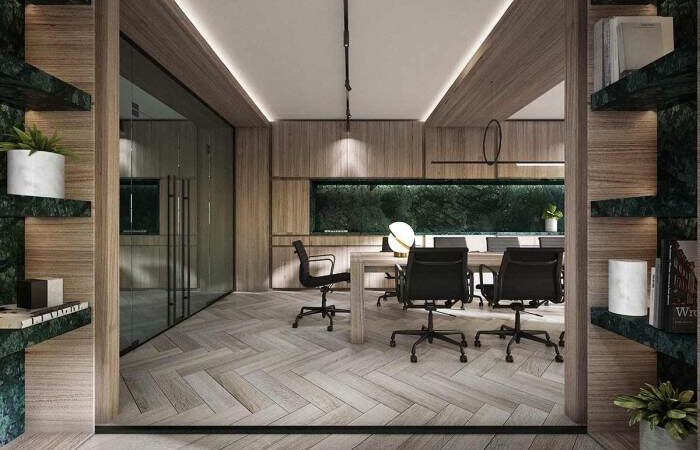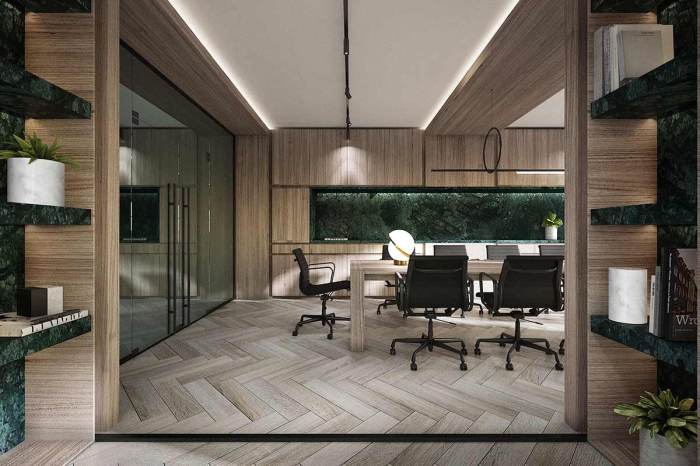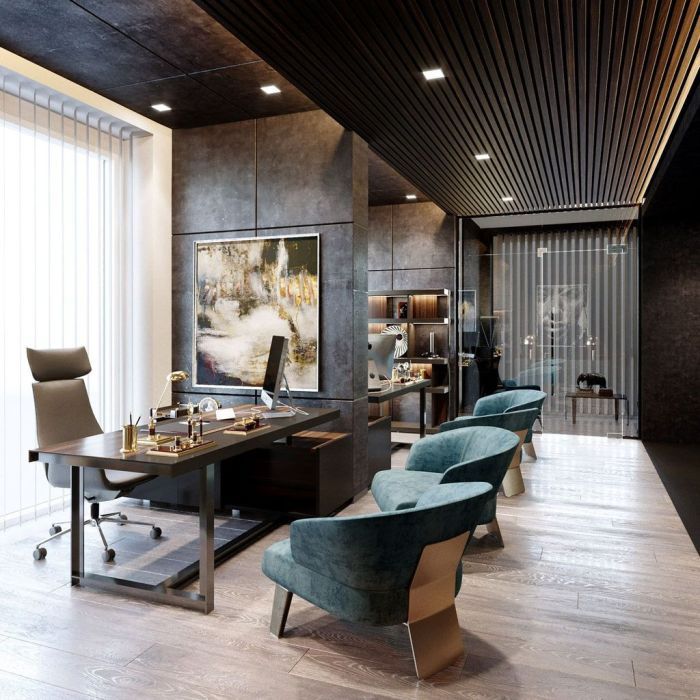Modern Office Interior Design: Creating Inspiring Workspaces

Modern office interior design has transformed the traditional workplace, embracing a dynamic approach that prioritizes employee well-being, productivity, and sustainability. This shift reflects a changing world of work, where technology, flexible workstyles, and a focus on employee experience have become paramount.
The evolution of office design has been driven by a desire to create spaces that foster collaboration, creativity, and a sense of belonging. Gone are the days of rigid cubicles and hierarchical structures. Instead, modern offices are characterized by open-plan layouts, biophilic design elements, and flexible workspaces that cater to diverse needs and preferences.
The Evolution of Office Design: Modern Office Interior Design

The modern office landscape has undergone a dramatic transformation, moving away from the rigid, hierarchical structures of the past and embracing a more dynamic and collaborative environment. This evolution is driven by a confluence of factors, including technological advancements, shifting workstyles, and a growing emphasis on employee well-being.
The Shift from Traditional to Modern Office Design
Traditional office layouts often featured rows of cubicles, private offices, and a centralized hierarchy. This design reflected a command-and-control approach to management, where information flowed vertically and collaboration was limited. In contrast, modern office design prioritizes open spaces, flexible work areas, and a focus on collaboration and communication.
This shift reflects a move toward a more agile and responsive work environment, where employees are empowered to work independently and collaboratively.
Key Elements of Modern Office Interior Design
Modern office design goes beyond aesthetics; it’s about creating functional and inspiring spaces that enhance productivity, collaboration, and employee well-being. This section delves into the key elements that define modern office design, exploring the principles, materials, and technologies that shape these dynamic work environments.
Open Plan Design, Modern office interior design
Open-plan layouts are a defining characteristic of modern offices, emphasizing collaboration and transparency. These layouts break down traditional cubicle walls, creating a more open and interconnected workspace. This approach fosters communication, promotes teamwork, and encourages a sense of community among employees.
However, careful planning is essential to manage noise levels and ensure privacy for focused work.
Biophilic Design
Biophilic design incorporates elements of nature into the built environment, aiming to create a more stimulating and healthy workspace. This approach leverages natural light, plants, and organic materials to connect employees with the outdoors, reducing stress and enhancing well-being. Studies have shown that incorporating natural elements in the workplace can boost productivity, improve mood, and reduce absenteeism.
Flexible Workspaces
Modern offices are designed to accommodate a variety of work styles and needs. Flexible workspaces allow employees to choose the setting that best suits their tasks, whether it’s a quiet corner for focused work, a collaborative space for brainstorming, or a comfortable lounge area for informal meetings.
This flexibility fosters a more engaged and productive workforce.
Color Palettes
Color plays a crucial role in shaping the mood and atmosphere of a modern office. Neutral palettes, often featuring shades of gray, white, and beige, create a clean and sophisticated backdrop. These palettes provide a calming and professional atmosphere, allowing vibrant accent colors to add pops of energy and personality.
Materials
Modern offices often utilize a mix of materials to create a balanced and aesthetically pleasing environment. Natural materials like wood, stone, and bamboo bring warmth and texture, while sleek metal and glass surfaces contribute to a modern and sophisticated feel.
Sustainable materials are increasingly favored, reflecting a growing awareness of environmental responsibility.
Lighting
Lighting is a key element in modern office design, influencing both functionality and ambiance. Natural light is maximized through large windows and skylights, providing a sense of openness and promoting employee well-being. Artificial lighting is carefully planned to provide adequate illumination for different tasks, with adjustable lighting systems allowing employees to personalize their workspaces.
Technology Integration
Technology plays a significant role in shaping modern office design. Wireless connectivity, smart devices, and digital displays are seamlessly integrated into the workspace, enabling efficient communication, collaboration, and access to information. Modern offices are designed to accommodate these technologies, with dedicated spaces for video conferencing, charging stations, and ergonomic workstations.
Creating a Functional and Inspiring Workspace
Modern office design goes beyond aesthetics; it prioritizes creating an environment that fosters employee well-being and maximizes productivity. This shift in focus acknowledges that happy and healthy employees are more engaged, creative, and productive.
Promoting Collaboration, Focus, and Comfort
A well-designed modern office layout caters to different work styles and needs. Open floor plans encourage collaboration and communication, while private spaces offer quiet areas for focused work. To enhance comfort, ergonomic furniture and natural light are essential.
- Collaboration Zones: Designated areas with comfortable seating, whiteboards, and collaborative tools encourage brainstorming and teamwork. Examples include communal tables, breakout rooms, and informal meeting spaces.
- Focus Zones: Quiet and private spaces provide a conducive environment for concentrated work. These can include individual offices, phone booths, or dedicated quiet zones.
- Comfort and Ergonomics: Ergonomic furniture, adjustable desks, and comfortable seating are crucial for employee well-being. This reduces strain on the body and promotes a healthy posture, leading to increased productivity and reduced fatigue.
The Importance of Ergonomic Furniture and Equipment
Ergonomic furniture and equipment are not just about comfort; they are essential for employee health and productivity. By reducing strain and promoting good posture, ergonomic design helps prevent musculoskeletal disorders and improves overall well-being.
“Ergonomics is the science of designing the workplace to fit the human body, reducing strain and promoting efficiency.”
The American Society of Ergonomics
- Adjustable Desks: Allow employees to switch between sitting and standing positions throughout the day, promoting blood circulation and reducing back pain.
- Ergonomic Chairs: Provide proper lumbar support, adjustable height, and armrests to ensure comfortable seating and prevent strain on the back and neck.
- Ergonomic Mouse and Keyboard: Reduce strain on the wrists and hands, promoting better posture and reducing the risk of repetitive strain injuries.
Sustainability in Modern Office Design

Sustainability has become a critical aspect of modern office design, reflecting a growing awareness of environmental responsibility and the need for long-term economic viability. Today’s forward-thinking organizations prioritize creating workspaces that minimize their environmental footprint while promoting well-being and productivity.
Eco-Friendly Materials and Sustainable Practices
The use of eco-friendly materials and sustainable practices is fundamental to achieving a truly sustainable office design. By incorporating these elements, businesses can reduce their reliance on harmful chemicals and minimize waste generation throughout the building’s lifecycle.
- Sustainable Building Materials: Using recycled content materials like reclaimed wood, bamboo, and recycled plastic in furniture and building components significantly reduces the demand for virgin resources and lowers carbon emissions. Examples include using bamboo flooring, which is a fast-growing and renewable resource, or incorporating recycled plastic into office furniture.
- Low-VOC Paints and Finishes: Choosing paints and finishes with low volatile organic compound (VOC) emissions helps improve indoor air quality and reduces harmful chemicals released into the environment. This ensures a healthier workspace for employees and minimizes the impact on surrounding ecosystems.
- Locally Sourced Materials: Prioritizing materials sourced locally reduces transportation distances and associated emissions, contributing to a smaller carbon footprint. This approach also supports local economies and strengthens community ties.
Minimizing Environmental Impact Through Design Choices
Strategic design choices can significantly minimize an office’s environmental impact, creating a workspace that respects the planet and its resources.
- Natural Lighting and Ventilation: Maximizing natural light through large windows and skylights reduces reliance on artificial lighting, lowering energy consumption and creating a more pleasant and productive work environment. Implementing well-designed ventilation systems that leverage natural air circulation further reduces energy dependence.
- Green Roofs and Vertical Gardens: Incorporating green roofs and vertical gardens not only enhances aesthetics but also provides insulation, reduces stormwater runoff, and improves air quality. These features create a more biodiverse and visually appealing workspace, promoting employee well-being and environmental responsibility.
- Water Conservation Measures: Installing low-flow plumbing fixtures, water-efficient landscaping, and rainwater harvesting systems significantly reduces water consumption. These measures conserve precious resources and minimize the impact on local water systems.
Innovative Design Solutions for Energy Efficiency and Waste Reduction
Modern office design offers innovative solutions for achieving energy efficiency and reducing waste generation, creating a more sustainable and cost-effective workspace.
- Smart Building Technologies: Implementing building management systems (BMS) that monitor and control energy consumption, lighting, and HVAC systems optimize energy efficiency. These systems can adapt to occupancy patterns and environmental conditions, reducing unnecessary energy use.
- Energy-Efficient Lighting: Replacing traditional incandescent bulbs with LED lighting significantly reduces energy consumption while providing superior illumination. This transition can lead to substantial cost savings and a reduced environmental footprint.
- Waste Reduction and Recycling Programs: Implementing comprehensive waste management programs, including recycling and composting initiatives, minimizes landfill waste and promotes resource conservation. This approach encourages a culture of environmental responsibility among employees and reduces the office’s overall environmental impact.
Modern Office Design Trends
The world of office design is constantly evolving, driven by technological advancements, changing workstyles, and a growing focus on employee well-being. Modern office design trends are not just about aesthetics; they are about creating spaces that foster collaboration, innovation, and productivity.
These trends are shaping the future of office spaces, making them more adaptable, sustainable, and human-centric.
Emerging Trends in Modern Office Design
The following trends are shaping the future of office spaces:
- Biophilic Design: This trend involves incorporating natural elements like plants, wood, and natural light into the office environment. Biophilic design aims to connect people with nature, creating a sense of calm, well-being, and improved focus. Studies have shown that incorporating natural elements can reduce stress, boost creativity, and improve overall productivity.
- Smart Technology Integration: Modern offices are increasingly integrating smart technology to enhance functionality and efficiency. This includes features like automated lighting, temperature control, and room booking systems. Smart technology can improve energy efficiency, optimize workspace utilization, and provide employees with greater control over their work environment.
- Flexible and Agile Workspaces: The traditional cubicle-filled office is giving way to more flexible and agile workspaces that cater to diverse work styles and preferences. This trend includes the use of open floor plans, hot desks, and collaborative workspaces. Flexible workspaces allow employees to choose the setting that best suits their task and work style, fostering collaboration and creativity.
- Focus on Well-being: Modern office design places a strong emphasis on employee well-being. This includes creating spaces that promote physical activity, healthy eating, and mental well-being. Features like ergonomic furniture, access to natural light, and designated spaces for relaxation and social interaction are becoming increasingly common.
- Sustainability and Eco-Conscious Design: Sustainable practices are increasingly important in office design. This includes using recycled materials, energy-efficient lighting and appliances, and incorporating green building features. Sustainable office design minimizes the environmental impact of the workspace while promoting a sense of social responsibility.
Impact of Trends on the Future of Office Spaces
These trends are having a significant impact on the future of office spaces, making them more:
- Adaptable: Modern offices are designed to be adaptable to changing needs and work styles. This includes the use of modular furniture, flexible layouts, and technology that can be easily upgraded.
- Sustainable: Sustainable practices are becoming increasingly important in office design, leading to spaces that are environmentally friendly and resource-efficient.
- Human-Centric: The focus on employee well-being is driving the creation of spaces that prioritize comfort, health, and productivity.
- Collaborative: Modern offices are designed to foster collaboration and teamwork, with features like open floor plans, shared workspaces, and technology that facilitates communication.
- Tech-Enabled: Smart technology is playing a crucial role in modern office design, enhancing efficiency, connectivity, and the overall user experience.
Final Thoughts
As we move forward, the future of office design will continue to be shaped by technological advancements, evolving workstyles, and a growing emphasis on sustainability. By embracing these trends, organizations can create inspiring and functional workspaces that attract and retain talent, foster innovation, and contribute to a more sustainable future.
Comments are closed.